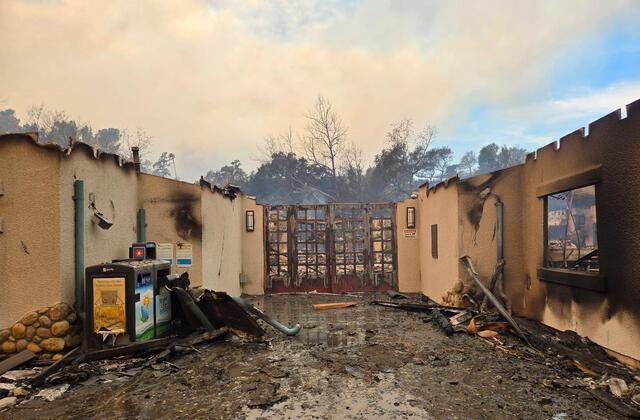Wildfires have become an all-too-common reality in Southern California, but the recent blazes raging across Los Angeles have dealt a particularly devastating blow. Beyond the tragic loss of homes and lives, the fires have destroyed vital outdoor education sanctuaries, reshaping the landscape of learning and recreation for local families.
The Loss of Outdoor Learning Spaces
For many families, outdoor education has been a cornerstone of their children’s development. Irina Contreras, a program manager for Los Angeles County’s Department of Arts and Culture, recalls how her 7-year-old daughter, Ceiba, thrived in these natural spaces. Ceiba’s adventures with her bilingual forest school, Matilija, and a children’s hiking group, Hawks, offered her hands-on learning experiences in places like Eaton Canyon Nature Area.
Located near Altadena, Eaton Canyon was a 190-acre preserve known for its educational programs and natural beauty. Ceiba and her friends spent their days exploring, journaling, and even discovering hidden trails. Tragically, Eaton Canyon is now unrecognizable, reduced to ashes by the fires.
According to Richard Smart, superintendent of Eaton Canyon Natural Area, the destruction is nearly total. “The wildflowers, the shrubs are gone,” he said. The center, which once hosted thousands of students annually for field trips, now stands as a haunting reminder of the fires’ power. Smart laments the loss not only of the natural landscape but also of a vital educational hub that was free, local, and beloved by the community.

Schools Ravaged by Fire
The wildfires have not spared traditional educational institutions either. Odyssey Charter School in Altadena, attended by Miguel Ordeñana’s children, suffered significant damage. Ordeñana, a senior manager at the Natural History Museum, describes the emotional toll on his family: “A lot of their friends lost their homes. We don’t know the impact to school staff, but many teachers lived in the area and have also lost everything.”
Meanwhile, schools in the Los Angeles Unified School District—the nation’s second-largest—were forced to close due to heavy smoke and ash. As of January 8, 335 schools across Los Angeles, San Bernardino, Riverside, Ventura, and San Diego counties had shut down. Pasadena Unified School District reported damage to several campuses, including Eliot Arts Magnet Middle School.
The Emotional and Educational Fallout
The loss of these spaces is about more than the physical destruction. For families like the Contreras and Ordeñana households, these sanctuaries were places of healing, growth, and connection. During the pandemic, Contreras found solace in stepping away from screens and immersing herself in outdoor activities with her daughter. Now, that refuge is gone.
Lila Higgins, a senior manager at the Natural History Museum and author of Wild L.A., emphasizes the importance of nature for children’s development. “Time in nature lowers heart rates, reduces blood pressure, and helps children with attention deficit disorders feel more calm and relaxed,” she explained. Beyond the health benefits, outdoor education fosters cognitive skills such as spatial orientation, relationship-building, and understanding human impact on the environment.
Hope for Recovery Amid Uncertainty
Despite the devastation, there is hope that these outdoor programs will return. Contreras remains optimistic, though it is unclear when it will be safe to resume hiking and exploring areas like Eaton Canyon. Greg Pauly, co-author of Wild L.A. and director of the Urban Nature Research Center, believes these spaces will eventually become field trip destinations again. However, he cautions, “It’s going to be a while before that happens.”
As the fires continue to burn, families and educators are left grappling with immediate challenges. Poor air quality has made even unaffected areas, such as Griffith Park, unsafe for outdoor programs. For many, the question of where to go next remains unanswered.
Adapting to a New Reality
“This is the reality of modern Southern California,” Pauly remarked. “Fire changes the landscape and people’s lives shockingly often.” While the community mourns the loss of these vital spaces, there is also resilience. Families like Ordeñana’s are finding ways to connect, gathering for pizza and indoor playdates to maintain a sense of normalcy.
Recovery will be a long road, but the spirit of Los Angeles—its families, educators, and community leaders—remains unbroken. Whether through rebuilding nature centers or reimagining outdoor programs, the city is determined to restore the sanctuaries that have meant so much to so many.
A Call to Action
The destruction of these educational and natural spaces highlights the urgent need for community support and proactive measures against wildfires. From funding for rebuilding efforts to initiatives that promote fire prevention and mitigation, there are ways for everyone to contribute.
As Los Angeles grapples with these challenges, one thing is clear: the bond between the city’s residents and its natural sanctuaries is unshakable. Together, they will rebuild and reclaim these spaces, ensuring future generations can continue to learn, explore, and thrive in the great outdoors.


